 | | | Switch to: Europe, USA, New Zealand, Antarctica Credit: NOAA/Ovation  Planetary K-index Planetary K-index
Now: Kp= 3 quiet
24-hr max: Kp= 4 unsettled
explanation | more data
Interplanetary Mag. Field
Btotal: 5.6 nT
Bz: 0.1 nT north
more data: ACE, DSCOVR
Updated: Today at 2351 UT  Coronal Holes: 04 Aug 17 Coronal Holes: 04 Aug 17 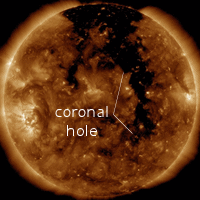
Solar wind flowing from this broad coronal hole should reach Earth on August 4th or 5th Credit: NASA/SDO.  Noctilucent Clouds They're back! Images of noctilucent clouds from NASA's AIM spacecraft are available again. The spacecraft's orbit had recently changed, requiring a new way to point AIM's science instruments. This problem has now been solved, and "daily daisies" have returned to Spaceweather.com. Switch view: Europe, USA, Asia, Polar Updated at: 08-03-2017 16:55:03 Noctilucent Clouds They're back! Images of noctilucent clouds from NASA's AIM spacecraft are available again. The spacecraft's orbit had recently changed, requiring a new way to point AIM's science instruments. This problem has now been solved, and "daily daisies" have returned to Spaceweather.com. Switch view: Europe, USA, Asia, Polar Updated at: 08-03-2017 16:55:03  SPACE WEATHER
NOAA Forecasts | | Updated at: 2017 Aug 04 2200 UTC FLARE | 0-24 hr | 24-48 hr | CLASS M | 01 % | 01 % | CLASS X | 01 % | 01 % |  Geomagnetic Storms: Geomagnetic Storms:
Probabilities for significant disturbances in Earth's magnetic field are given for three activity levels: active, minor storm, severe storm Updated at: 2017 Aug 04 2200 UTC Mid-latitudes | 0-24 hr | 24-48 hr | ACTIVE | 35 % | 30 % | MINOR | 25 % | 10 % | SEVERE | 05 % | 01 % | High latitudes | 0-24 hr | 24-48 hr | ACTIVE | 10 % | 15 % | MINOR | 25 % | 30 % | SEVERE | 65 % | 45 % | | | |  | | | | | | | | | | | Lights Over lapland is excited to announce that Autumn Aurora Adventures are available for immediate booking! Reserve your adventure of a lifetime in Abisko National Park, Sweden today! | | | SOLAR WIND STORM: As predicted, Earth has entered a stream of solar wind blowing around our planet faster than 700 km/s. First contact with the stream did not produce a geomagnetic storm. Nevertheless, polar geomagnetic storms (G1- and G2-class) remain possible on Aug. 4th and 5th as our planet moves through this region of space. Free: Aurora Alerts NOCTILUCENT CLOUDS: NASA's AIM satellite is monitoring a luminous ring of electric-blue around Earth's north pole. The glow comes from noctilucent clouds (NLCs). These are, essentially, clouds of frosted meteor smoke floating at the interface between our planet's atmosphere and space. In recent days, cloudy tendrils have reached down into northern Europe, filling the night sky with silvery ripples. Ronny Tertnes sends this picture from Bergen, Norway: 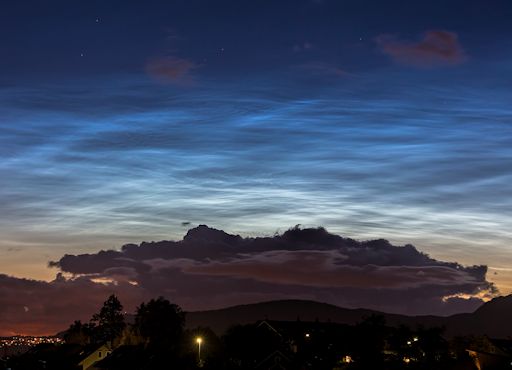
"There were an amazing amount of bright noctilucent clouds just after midnight on August 3rd," says Tertnes. "They appeared high above a dark mass of dissipating storm clouds--a fine contrast."
Indeed, Tertnes picture illustrates the difference between ordinary clouds (low-hanging and dark in the night sky) vs. noctilucent clouds (glowing brightly even at midnight from their rarefied domain more than 80 km above Earth's surface). The former is a denizen of Earth, the latter a relative of space. More of these amazing clouds may be seen in the NLC photo gallery: Realtime Noctilucent Cloud Photo Gallery SOLAR ECLIPSE PENDANTS: Would you like to support our Solar Eclipse Balloon Network? Here's one way: Buy a space pendant. This solar eclipse-themed necklace flew to the stratosphere on July 2, 2017, attached to the payload of an Earth to Sky Calculus space weather balloon: 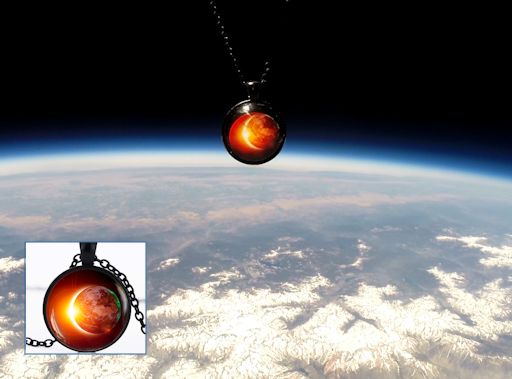
The payload contained more just like it. If you buy one now for $89.95, we will fly it back to the stratosphere during the Great American Solar Eclipse on August 21, 2017, where it will be enveloped by the Moon's cool shadow above our launch site in Oregon. No additional charge! Just make a note in the COMMENTS BOX of the shopping cart: "Please fly my pendant into the eclipse!" Each pendant comes with a greeting card showing the jewelry in flight and telling the story of its journey to the stratosphere and back again. More items from the edge of space may be found in the Earth to Sky Store. All proceeds support atmospheric radiation monitoring and hands-on STEM education. Far Out Gifts: Earth to Sky Store
All proceeds support hands-on STEM education LONELY SUNSPOT: The sun is plunging toward a deep Solar Minimum, and this is making sunspots lonely. Last night in Nîmes, France, Philippe Tosi photographed sunspot AR2670 as the sun set behind the hills of his hometown. It was all by itself: 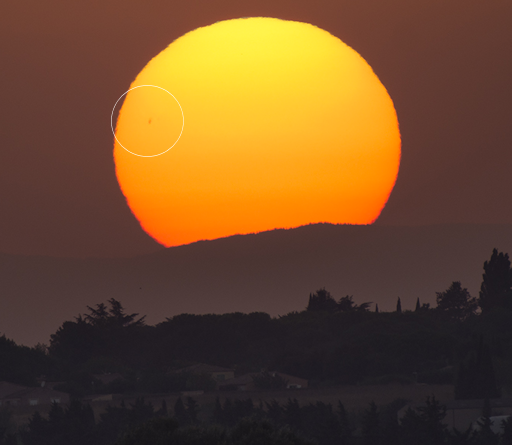
"Alone on the otherwise blank disk of the sun, sunspot AR2670 was clearly visible in this picture," says Tosi. "It was a lovely sunset."
AR2670 is the corpse of old sunspot AR2665, a former behemoth that sparked geomagnetic storms in mid-July when it first crossed the face of the sun. Even then, the sunspot was all by itself, unattended by other dark cores that typically pepper the sun during more active phases of the solar cycle. If the decay of AR2670 continues apace, it will soon be gone as well, leaving the sun completely blank. Stay tuned for Solar Minimum. Realtime Space Weather Photo Gallery
Realtime Aurora Photo Gallery
Every night, a network of NASA all-sky cameras scans the skies above the United States for meteoritic fireballs. Automated software maintained by NASA's Meteoroid Environment Office calculates their orbits, velocity, penetration depth in Earth's atmosphere and many other characteristics. Daily results are presented here on Spaceweather.com. On Aug. 4, 2017, the network reported 56 fireballs.
(42 sporadics, 8 Perseids, 5 Southern delta Aquariids, 1 alpha Capricornid) 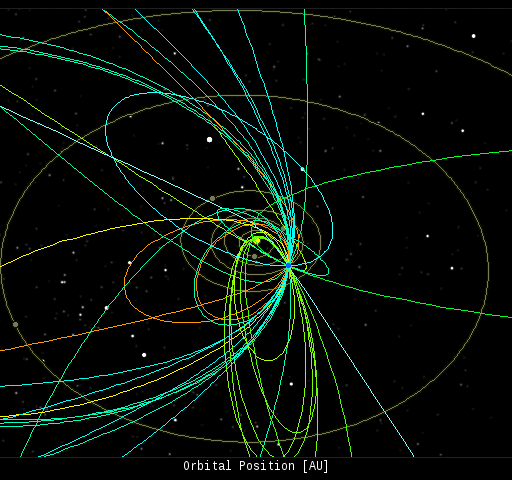 In this diagram of the inner solar system, all of the fireball orbits intersect at a single point--Earth. The orbits are color-coded by velocity, from slow (red) to fast (blue). [Larger image] [movies] Potentially Hazardous Asteroids ( PHAs) are space rocks larger than approximately 100m that can come closer to Earth than 0.05 AU. None of the known PHAs is on a collision course with our planet, although astronomers are finding new ones all the time. On August 4, 2017 there were 1803 potentially hazardous asteroids.  | Recent & Upcoming Earth-asteroid encounters: | Asteroid | Date(UT) | Miss Distance | Velocity (km/s) | Diameter (m) | | 2011 CC22 | 2017-Aug-04 | 15.5 LD | 18.4 | 186 | | 2017 NB7 | 2017-Aug-06 | 6.9 LD | 6 | 80 | | 2017 OF7 | 2017-Aug-10 | 19.2 LD | 8.1 | 89 | | 2014 OA339 | 2017-Aug-13 | 12.3 LD | 10 | 47 | | 2017 PE | 2017-Aug-24 | 19.5 LD | 7.1 | 46 | | 3122 | 2017-Sep-01 | 18.5 LD | 13.5 | 5376 | | 2014 RC | 2017-Sep-11 | 15.1 LD | 8.9 | 16 | | 1989 VB | 2017-Sep-29 | 7.9 LD | 6.3 | 408 | Notes: LD means "Lunar Distance." 1 LD = 384,401 km, the distance between Earth and the Moon. 1 LD also equals 0.00256 AU. MAG is the visual magnitude of the asteroid on the date of closest approach. | | Cosmic Rays in the Atmosphere |
Readers, thank you for your patience while we continue to develop this new section of Spaceweather.com. We've been working to streamline our data reduction, allowing us to post results from balloon flights much more rapidly, and we have developed a new data product, shown here: 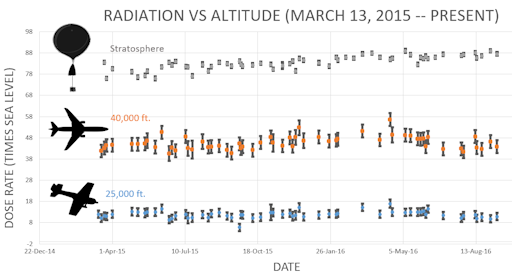
This plot displays radiation measurements not only in the stratosphere, but also at aviation altitudes. Dose rates are expessed as multiples of sea level. For instance, we see that boarding a plane that flies at 25,000 feet exposes passengers to dose rates ~10x higher than sea level. At 40,000 feet, the multiplier is closer to 50x. These measurements are made by our usual cosmic ray payload as it passes through aviation altitudes en route to the stratosphere over California. What is this all about? Approximately once a week, Spaceweather.com and the students of Earth to Sky Calculus fly space weather balloons to the stratosphere over California. These balloons are equipped with radiation sensors that detect cosmic rays, a surprisingly "down to Earth" form of space weather. Cosmic rays can seed clouds, trigger lightning, and penetrate commercial airplanes. Furthermore, there are studies ( #1, #2, #3, #4) linking cosmic rays with cardiac arrhythmias and sudden cardiac death in the general population. Our latest measurements show that cosmic rays are intensifying, with an increase of more than 13% since 2015: 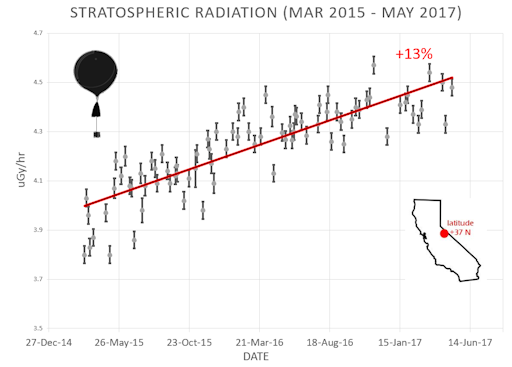
Why are cosmic rays intensifying? The main reason is the sun. Solar storm clouds such as coronal mass ejections (CMEs) sweep aside cosmic rays when they pass by Earth. During Solar Maximum, CMEs are abundant and cosmic rays are held at bay. Now, however, the solar cycle is swinging toward Solar Minimum, allowing cosmic rays to return. Another reason could be the weakening of Earth's magnetic field, which helps protect us from deep-space radiation. The radiation sensors onboard our helium balloons detect X-rays and gamma-rays in the energy range 10 keV to 20 MeV. These energies span the range of medical X-ray machines and airport security scanners. The data points in the graph above correspond to the peak of the Reneger-Pfotzer maximum, which lies about 67,000 feet above central California. When cosmic rays crash into Earth's atmosphere, they produce a spray of secondary particles that is most intense at the entrance to the stratosphere. Physicists Eric Reneger and Georg Pfotzer discovered the maximum using balloons in the 1930s and it is what we are measuring today. | | The official U.S. government space weather bureau | | | The first place to look for information about sundogs, pillars, rainbows and related phenomena. | | | Researchers call it a "Hubble for the sun." SDO is the most advanced solar observatory ever. | | | 3D views of the sun from NASA's Solar and Terrestrial Relations Observatory | | | Realtime and archival images of the Sun from SOHO. | | | from the NOAA Space Environment Center | | | a proud supporter of science education and Spaceweather.com | | | fun to read, but should be taken with a grain of salt! Forecasts looking ahead more than a few days are often wrong. | | | from the NOAA Space Environment Center | | | the underlying science of space weather |  | Beautyz for top beauty products reviews and their buying guides |  | Reviews here can help you to pick up best memory foam mattresses. | | | These links help Spaceweather.com stay online. Thank you to our supporters! | | | | | | | | |  | |  |   | ©2017 Spaceweather.com. All rights reserved. This site is penned daily by Dr. Tony Phillips. | |

